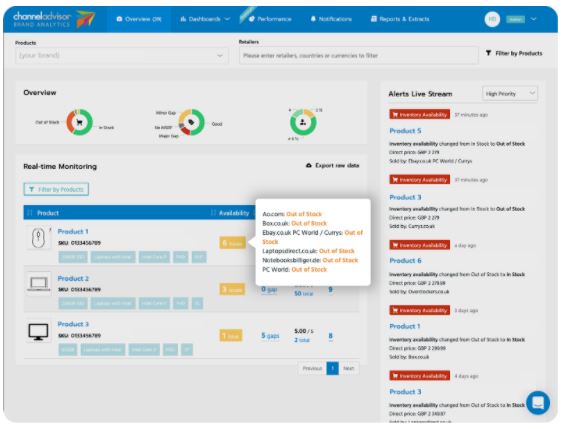
More brands are expanding their e-commerce presence as the industry continues to grow. And, increasingly, brands are aware of the importance of product page content, which has a direct impact on brand image and conversion rate.
Meeting the basic requirements for every product listing is a must. Ideally, listings should always stay up to date and best represent your brand and products to customers.
However, through our work with a variety of major brands from different industries, we often hear the top challenge that online retailer and e-commerce teams face with product page content: managing product page content at scale. That means trying to keep product page content up to the brand’s standards for numerous SKUs across multiple retailers sites, sometimes even across global borders.
This gets even more complicated for brands and manufacturers who distribute through online retailers that don’t allow direct updates or changes to content on the brand’s product listings. When brands want to make changes, they need to inform the retailers to make the updates instead. That could be frustrating, especially for the e-commerce teams who have invested significant time and effort to produce high-quality e-commerce content. And it can be especially time-consuming to communicate those updates to multiple retailers.
To help you more quickly recognize and address product page issues, we’ve compiled some of the most common mistakes and potential causes behind them.
Images
In fact, the human brain processes images 60,000 times faster than text, and 90% of information transmitted to the brain is visual. So clearly, you don’t want to ignore the opportunity to make a visual impact. Problems with images that frequently require further attention include:
- Too few images: Listings with a single image tend to deflect conversions at a glance, because there are not enough details for shoppers to take into consideration.
- Outdated images: Updating product images need to be aligned in implementation. However, teams tasked with online merchandising often can’t make direct changes on the retailer’s page. That creates discrepancies in listings of the same product that can confuse your consumers and hurt your brand overall.
- Wrong images: With the updating of product images still being a manual process for many retailers, it’s not uncommon for the wrong image to make its way to the product page, which can erode consumers’ trust in the listing.
Texts
A product description is like a digital salesperson. Would you feel confident buying from someone who didn’t explain the product well? Neither would most other shoppers. One e-commerce study conducted by the Nielsen Norman Group found that missing or unclear product information could contribute to 20% of purchase failures. Here are a few of the typical errors that occur in product descriptions:
- Wrong/too short title: An inaccurate title will mislead customers and significantly reduce the conversion rate for a product listing, while too short of a title tends to affect the search result ranking at the retailers.
- Missing/wrong description: Similar to the product title, a wrong description causes confusion, and, furthermore, can influence the search result ranking as search algorithms can pick out keywords that match initial search queries.
- Missing bullet point section: Bullet points or their alternatives help shoppers quickly scan for the feature or value that they are looking for. A listing with poor construction will cause fatigue in shoppers, and they might just skip the page altogether.
- No specs/features: Especially for electronics products, being able to scan the features in the description can help customers fast-forward the decision-making process.
- Illegal claims in the description: Product descriptions need to be accurate and help close the gap of expectations for customers. False claims put the listing at risk of not being published — or receiving complaints.
Ratings and Reviews
Viewing ratings and feedback from other customers is becoming a critical part of how shoppers evaluate your products. The following issues can potentially affect their purchasing decisions:
- Too few ratings: A lack of ratings could be a challenge, especially for new listings. Without ratings or reviews, the product may not have enough references to help the buyer make a decision.
- Average rating too low: The struggle is real. Low ratings require effort and high responsiveness before they start driving down sales and hurting your brand image.
- No detailed reviews: Shoppers are more cautious than before, so when a listing has great ratings but no reviews, some might start wondering about the credibility of the ratings.
Other Media
As e-commerce and technology continue to evolve, so does the inclusion of other types of media in product page content. Depending on your product, missing these components could cost you sales:
- No videos: If your product sales would not benefit from including a video, that’s fine. But if your brand created a video specifically for the listing, yet the video hasn’t been uploaded on all of the listings for that product, the effort goes to waste instead of adding value to the listing.
- Rich content not published: Rich content requires extra budget and effort, so obviously, your brand would want to make it worthwhile. If it didn’t get published because the account manager in charge of your brand at the retailer somehow overlooked the task, it would be such a waste.
- Not SEO-optimised: Keywords play an important role in the search result ranking and how retailers index your listings in their categories. So you need to pay attention to getting this right, strategically.
These issues could happen to any product pages, and they can have a direct impact on several key performance indicators (KPIs) for your brand. Watch this webinar to find out what KPIs are influenced by product page content, and learn more about how Clarins — a global beauty brand and a client of ChannelAdvisor Brand Analytics — has overcome this challenge and frequently maintains a strong brand presence across retailers.
Managing product data — and doing it well — comes with significant challenges. Content Performance, a feature from ChannelAdvisor Brand Analytics, automatically scans the content of your product pages to help you track implementation, compliance and consistency. Meanwhile, ChannelAdvisor Managed Services for Retail Content Management helps brands store, optimize and map product data to a retailer’s native product template by leveraging our robust data transformation engine. Reach out to ChannelAdvisor today and see how our team can help your brand accelerate its e-commerce journey.






